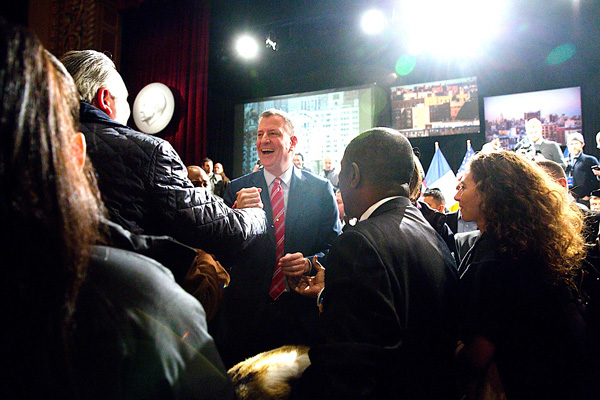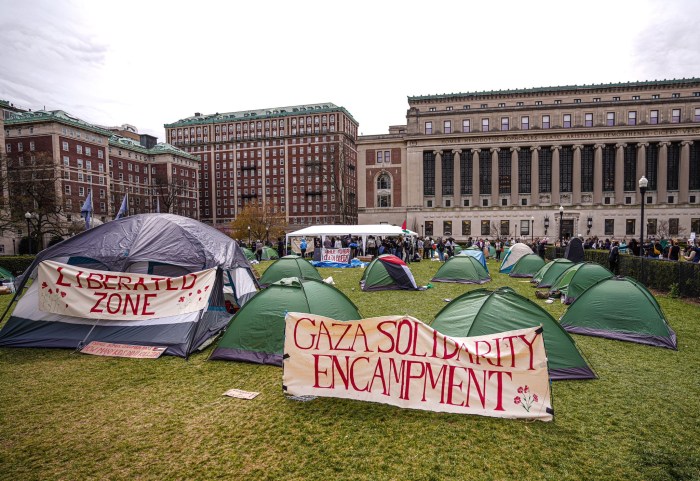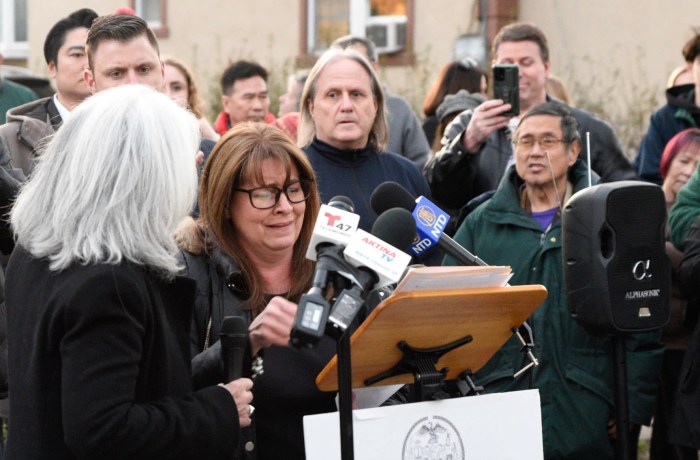
BY LINCOLN ANDERSON | Affordable housing was the centerpiece of Mayor de Blasio’s State of the City address at Baruch College on Tuesday.
The mayor, who campaigned on a platform of fighting income inequality in what he called the “Tale of Two Cities,” said much work remains in order to close the gap.
On Tuesday, he said the city continues to be perilously close to becoming “a gated community” and that such a sense of “exclusivity” has no place here.
More than half of New Yorkers currently pay more than 30 percent of their income toward rent, which means they are, by definition, “rent-burdened,” he stressed. Addressing that problem is the best and most-direct way to address the affordability crisis, he said.
“How did we get here?” he asked rhetorically. “For decades, we let the developers write their own rules. That meant a bias toward luxury housing. This administration is taking a totally and fundamentally different approach.”
The highlight of his affordable housing plan — which he likened to the original mission of Stuyvesant Town — was a scheme to build 11,250 units of affordable housing on the Sunnyside Yards rail yards in Queens. In fact, that is the same number of units as Stuy Town, he noted.
The rail yards would need to have platforms built over them, as in the Hudson Yards development plan on Manhattan’s West Side. This new housing would stay affordable forever, he noted.
For the record, he is keeping his eye on what is going on at Stuy Town, he said, in terms of trying to keep it as affordable as possible.
However, whereas the Hudson Yards are only a few acres, the Sunnyside Yards are 167 acres — with much of that under the control of the M.T.A.

In addition, shortly after de Blasio’s speech, Governor Cuomo, who controls the M.T.A., said through a spokesperson that the Queens rail yards are not currently available for any such project.
De Blasio also announced plans for creating 1,500 units of affordable live/work spaces for artists and musicians — plus 500 affordable dedicated work spaces for them — as well as 10,000 affordable units for seniors, and pledged to house homeless veterans.
Artists who come to New York from all over, he said, have historically helped give the city its creative flavor and are an essential part of what makes the city what it is. And that, in turn, makes New York a place that people want to visit. Tourism was at a record high last year, he noted, with more than 50 million visitors.
He called for mandatory inclusionary affordable housing in recently rezoned areas of the city, such as the southwest Bronx and East Harlem.
This will mean taller towers, but these will be sited in former manufacturing-zone areas, where there has been no housing before.
“We are not embarking on a mission to build skyscrapers where they don’t belong,” he explained.
Over all, his plan would create and / or preserve a total of 200,000 units affordable for low- and middle-income New Yorkers.
He noted that, under his administration, the Rent Guidelines Board last year passed the smallest rent increase in its history.
He then discussed the “G” word, gentrification, which he said is a mix of good and bad. In the past 20 years, the city has gotten much safer, and crime is at historic lows, he noted. He earlier had given a shout-out to the police for achieving that feat.
The city’s safety, he said, “has been, in many cases, a positive of gentrification. The negative point is when we reach the tipping point and New Yorkers are forced out of their neighborhoods.”
He slammed “slumlords” and “predatory landlords,” the former who deprive tenants of legally required services and repairs, the latter who swoop in on booming neighborhoods and “harass and push out tenants,” as he put it, so they can capitalize on the hot real-estate market.
“They’re law breakers — they literally break the law,” the mayor declared, “and they need to feel the consequences of their actions.”
De Blasio touted his passage of universal pre-K last year, saying he had defied the skeptics.
“When it comes to affordable housing, we will prove them wrong again,” he vowed.
“If you can afford to live here,” he said, “then everything becomes more possible, what you want to do and achieve here.
“We cannot allow ourselves to become a place of exclusivity,” he emphasized. “We cannot disconnect from our heart and our soul, or it won’t work.”
Some, however, said that while offering sweeping ideas about affordable housing, the mayor’s speech could have offered more concrete details about how it will all get done.
In addition, de Blasio announced a plan for increased commuter ferries between the boroughs, with rides priced at the same rate as a MetroCard swipe. The scheme would include a ferry stop at Grand St., which was hailed by City Councilmember Margaret Chin, in particular, while other East Side elected officials praised the plan in general.

















